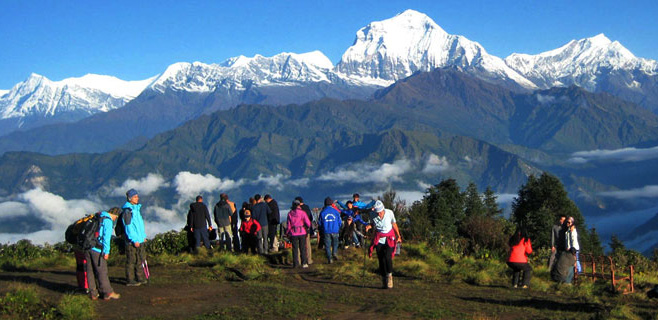The Ghorepani Poon Hill trek is popular and relatively one of the easiest treks in the Annapurna region. Traverse through charming ethnic Magar and Gurung villages, interact with local people, and immerse in their culture, and lifestyle. This short duration Ghorepani Poon Hill trek is also renowned as ‘Photographer’s Paradise’. Poon Hill, the vantage point for sunrise and sunset views over snow-capped peaks is every photographer’s delight. The views from Poon Hill captivates everyone. The scenic vistas, panoramic mountain views, beautiful Pokhara Valley, and sunrise or sunset add more value. Witness the awesome views of the Machhapuchhre, Annapurna, and Dhaulagiri ranges from Poon Hill. This trek is likely to leave an impression and desire more, ensuring repeat visits.
Guesthouses or lodges are accommodation means during the trek where full board 3-course meals are served. Guesthouses are basic but comfortable and offer a bed, pillows, and a blanket. Pay an extra cost for the use of Wi-Fi, laundry, hot water, shower, and charging devices. The attached bathrooms are available.
Breakfast, Lunch, and Dinner are meals served during the trek from guesthouses or lodges. From authentic Nepali Dal-Bhat dishes to continental dishes various options are there. Eggs, noodles, soups, roti, coffee, tea, etc. are some popular choices.
Tap water, bottled water, and boiled water are drinking water options during the trek. Bottled water costs USD 2 to 3 while pay an additional charge for boiled water in guesthouses. For safe drinking water, always carry water purifying solutions and a water bottle for ease.
Internet and Phone networks during the trek are stable and have strong connections Moreover, buy a local SIM for calls and use a data pack for using Wi-Fi.
Ghorepani Poon Hill trek can be done throughout the year. All seasons offer different views but still many consider Spring as the best season followed by Autumn. In these seasons, the weather is stable with mild to warm temperatures, clear skies, phenomenal views, comfortable trails, and mesmerizing sunrise and sunset views over snow-capped peaks. Due to heavy rainfall during monsoons and cold weather during winter seasons, very few travelers prefer these seasons.

Poon Hill at an elevation of 3210 m is the maximum elevation during the Ghorepani Poon Hill Trek. This is a relatively easy trek and is not very difficult compared to the Annapurna and Everest base camp treks. Still, a good level of fitness requires walking for long hours daily. Prepare and plan well as this trek is easily doable.
Getting altitude sickness during the Ghorepani Poon Hill trek is very minimal as the highest elevation is at 3210 m. This elevation is considered the safe altitude mark. For only a few hours, trekkers will be here, and getting altitude sickness is very low. But, still, precautions are necessary. Some common Symptoms of altitude sickness are headache, nausea, and breathing issues. Inform your guides if you experience any symptoms during the trek.
Preventive measures for Altitude Sickness are:
Good fitness during the trekking is always commendable. Familiarity with mountainous terrain, previous trekking experiences along with good health and physical fitness are favorable factors during this trek.
Travel Insurance is essential to have as it safeguards from emergencies and unforeseen events. Get insurance from a reputed travel insurance company. Be covered for medical treatment, helicopter rescue, accidents, flight cancellations, loss/theft of belongings, and unforeseen events.
Guides and porters during the Ghorepani Poon Hill treks are completely trekker’s personal preference. But, we still recommend having a guide and a porter for a smooth, better, and memorable trekking experience. Their knowledge and skill proved to be beneficial.
Annapurna Conservation Area Permit (ACAP)
USD 30/person (Foreigners)
NPR 1000/person (SAARC)
Trekkers Information Management System (TIMS)
USD 20/person (Foreigners)
NPR 1000/person (SAARC)
NPR 500/person (Foreign Officials)
Sleeping bag
Down jacket
LED headlight
Water bottle
First-aid kit
Water purification solution
Trekking Poles
Raincoat
Sunglasses
Socks
Sunscreen
Days: Activities
01: Kathmandu Arrival (1,300m/4,264ft)
02: Kathmandu Valley Sightseeing
03: Drive from Kathmandu to Pokhara (915m) – 7 Hours
04: Drive from Pokhara to Nayapul, then trek to Tikhedhunga (1577m) – 4 Hours
05: Trek from Tikhedhunga to Ghorepani (2840m) – 5 Hours
06: Hike up to Poon Hill (3210m) and trek to Tadapani (2610m) – 5 Hours
07: Trek from Tadapani to Ghandruk (1940m) – 5 Hours
08: Trek from Ghandruk to Nayapul (1010m), then drive to Pokhara – 5 Hours
09: Drive back to Kathmandu from Pokhara
10: Final Departure